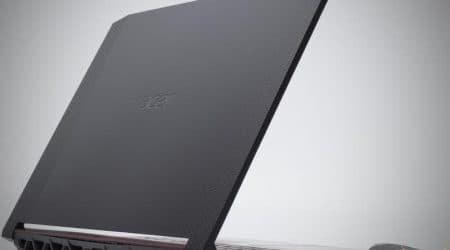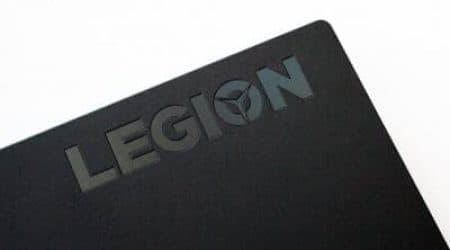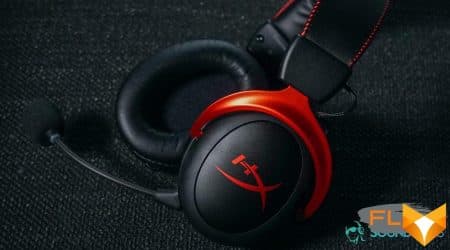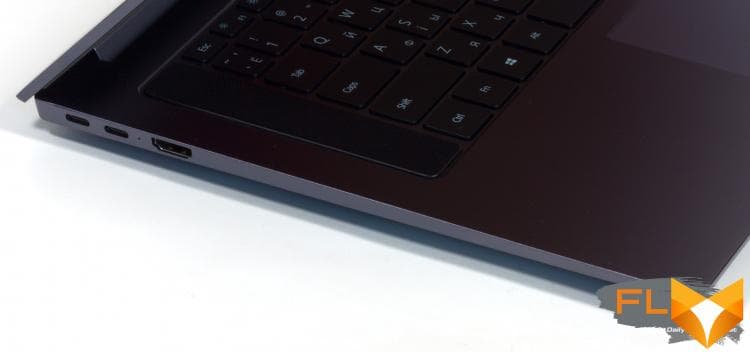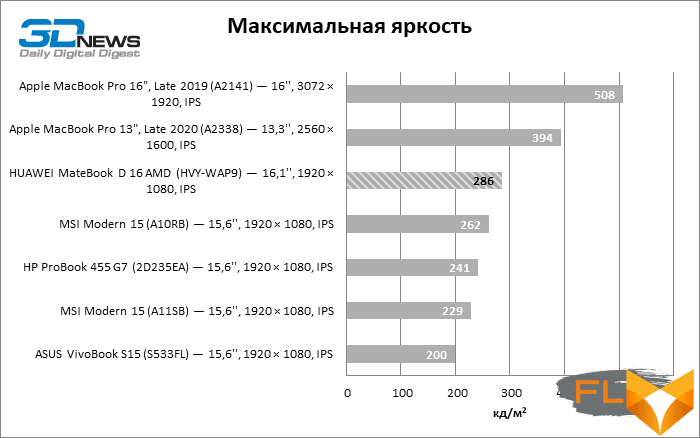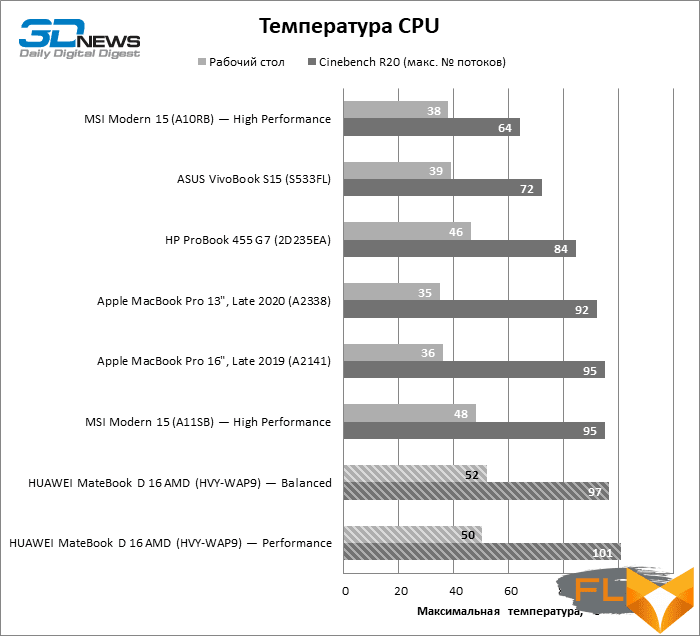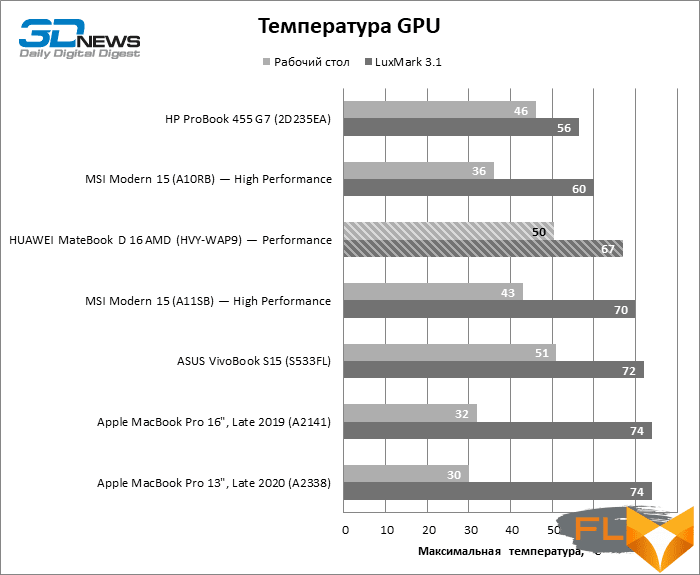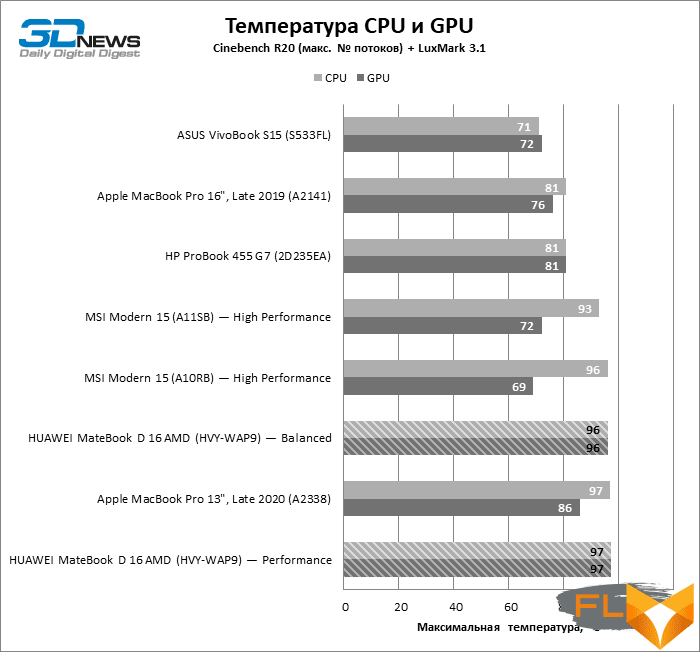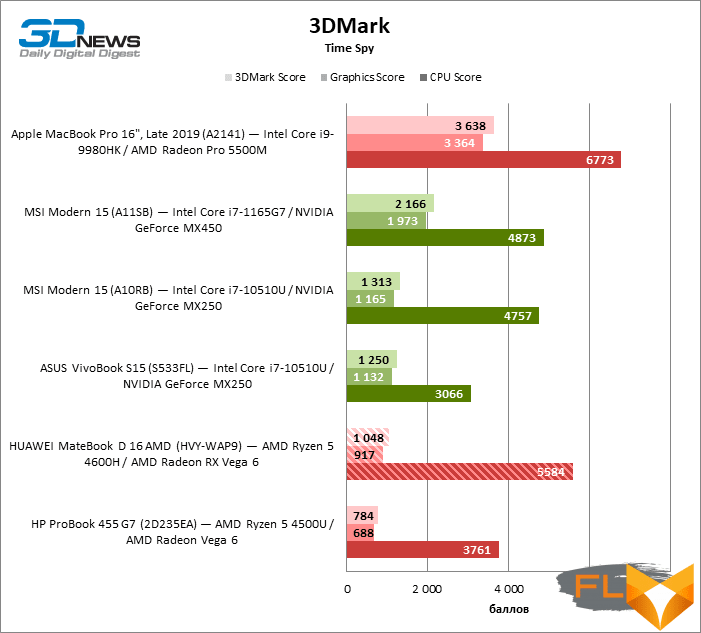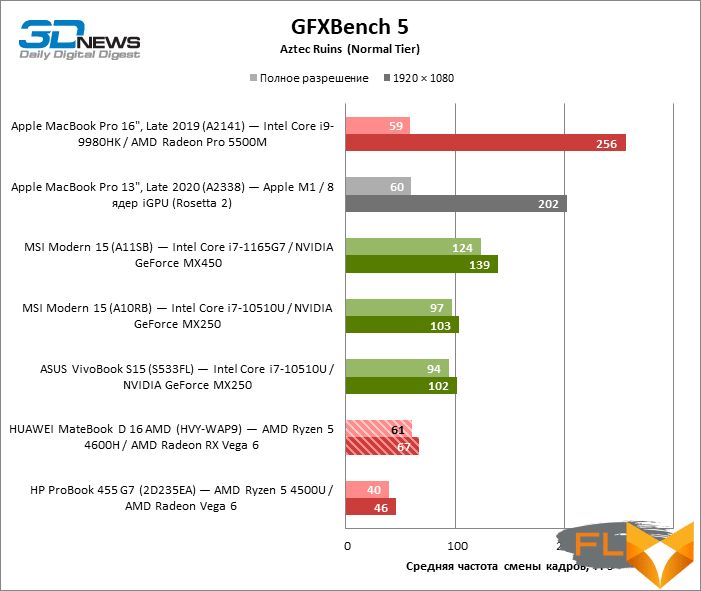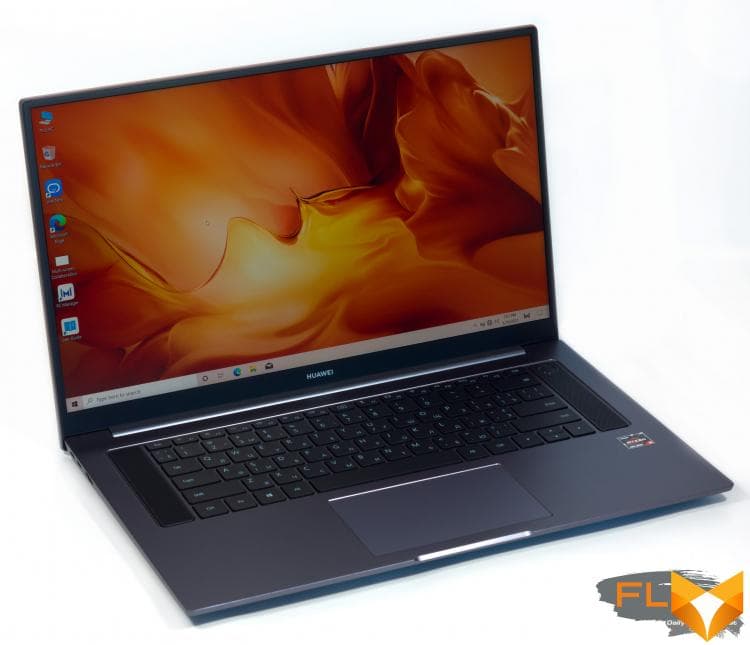


HUAWEI hasn’t been in the laptop business for too long, but it’s already released quite a few devices that outperform the more well-known companies in the field in many ways. Take, for example, the recent MateBook 13 AMD, a remarkable ultrabook, which was let down only by an inconvenient configuration of connectors, and even an outdated CPU platform Ryzen 3000. The HUAWEI MateBook D 16 AMD is immune from such problems. It uses a fresh “red” 4000-series processor, and thanks to a larger form factor, you can not save on cable interfaces. MateBook D 16 is one of the few laptops with a 16.1-inch screen instead of the usual 15.6. Why not, because the car still remained thin and light.

⇡#Specifications, prices
Unlike the vast majority of modern ultrabooks, which are equipped with low-wattage varieties of Intel or AMD chips, the HUAWEI laptop has a full-power CPU. All machine configurations include a six-core Ryzen 5 4600H processor rated for power consumption up to 54W. In addition, this model supports SMT, so the laptop definitely does not complain about CPU speed. But the thin MateBook D 16 AMD chassis is no longer suitable for powering and cooling a discrete GPU, along with a powerful central processor. The laptop relies on the integrated graphics Radeon RX Vega 6, which, of course, significantly limits its potential in work applications and makes the computer unsuitable for any modern games, except for the most undemanding of them.
Judging by the description on the manufacturer’s website, the only variable in the specifications of the MateBook D 16 AMD is the amount of RAM – 8 or 16 GB. And by the way, it will no longer be possible to increase RAM after purchase, since the chips are soldered directly on the motherboard. The amount of ROM is always the same – 512 GB.
| Manufacturer | Huawei |
|---|---|
| Model | Matebook D 16 AMD |
| Display | 16.1”, 1920 × 1080, IPS |
| CPU | AMD Ryzen 5 4600H (6/12 cores/threads, 3.0-4.0GHz) |
| RAM | DDR4 SDRAM, 3200 MT/s, 8/16 GB (dual channels) |
| GPU | AMD Radeon RX Vega 6 (512MB of system RAM) |
| Drive | WD PC SN730 (PCIe 3.0 x4) 512 GB |
| External I/O connectors | 2 × USB 3.2 Gen 1 Type-C/DisplayPort; 2 x USB 3.2 Gen 1 Type-A; 1 x HDMI; 1 x TRS 3.5mm |
| Network | IEEE 802.11ax + Bluetooth 5.1 |
| Battery capacity | 56 Wh |
| Weight, kg | 1.74 |
| Overall dimensions (L × H × D), mm | 369 × 234 × 18.4 |
| Retail price | $1200 (16 GB) |
Aside from the ARM-based Apple M1 chip, the low-wattage variants of the Ryzen 4000-series have unmatched performance in their class, and only Intel’s latest Tiger Lake silicon can compete in a number of applications. And we expect even better results from a full power Ryzen processor. But HUAWEI’s choice of an AMD platform means that buyers of the AMD MateBook D 16 won’t be able to use the Thunderbolt interface, and the USB type isn’t the fastest either.
Be that as it may, the HUAWEI product fully fulfills its cost. $1200 is a great price even for the basic components of a laptop. Not to mention other qualities that are not expressed in dry numbers: for example, a well-tuned screen matrix or a case with a comfortable keyboard and touchpad.
⇡#Look and Ergonomics
The hallmark of the HUAWEI MateBook D 16 AMD is, of course, a large screen with a diagonal of 16.1 inches. Thanks to the narrow bezels, it managed to fit into the dimensions typical of 15-inch laptops of yesteryear – just like 14-inch laptops actually removed their 13-inch predecessors from the market. Of course, AMD’s MateBook D 16 is still larger than most ultrabooks, but otherwise it’s still a typical ultrabook: the device weighs only 1.74 kg, and its thickness is only 18.4 mm.

It’s easy to see that HUAWEI continues to borrow good designs from Apple. First, the 16.1-inch screen itself, which is used in the older model of the MacBook Pro. Secondly, AMD’s MateBook D 16 also looks like Apple laptops, although it looks like the company has already found its own corporate identity. More importantly, HUAWEI also prefers to make cases from thicker metal panels. As a result, the lid of the laptop turned out to be quite rigid in bending, despite the fact that the screen panel is not laminated with glass. The latter is clearly for the best, because HUAWEI computers have had problems with anti-glare coatings in the past.
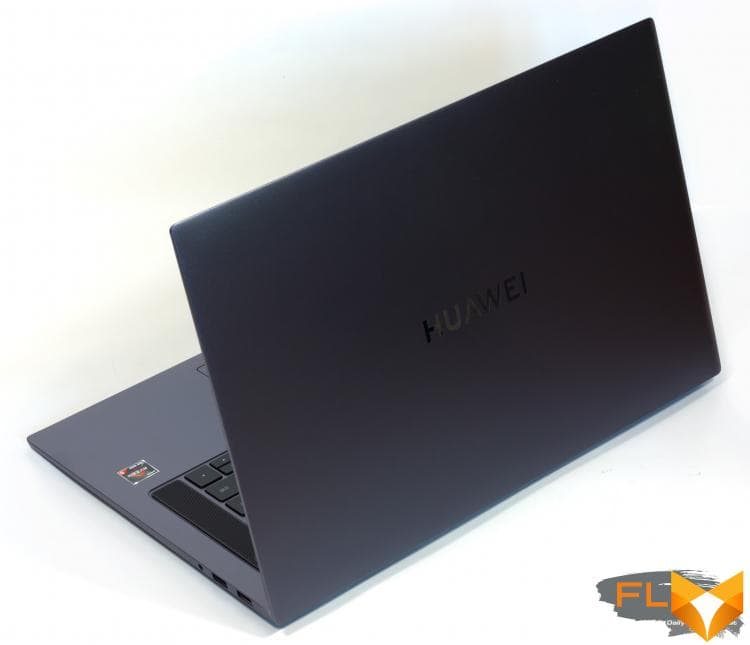
Finally, HUAWEI figured out that one of the main advantages of any “Macbook” is the keyboard and touchpad. There is plenty of room on the AMD MateBook D 16 work surface so you don’t have to sacrifice key width (only the “~” key got it). And most importantly, according to the sensations from the mechanisms, the laptop is very reminiscent of the 13-inch versions of the MacBook. In particular, this means a pronounced actuation moment and a quick return of the keys to the neutral position. Equally important is the fact that the base of the keyboard almost does not flex during the typing process. The power button was separated from the rest of the keys: firstly, it is more convenient, and secondly, a biometric sensor is integrated into it, which is doubly convenient.
The touchpad on the MateBook D 16 AMD is covered in glass and is large and well-tuned. But there is an offensive defect: between the sensitive panel and the metal of the working surface there is a gap as thick as a nail.

There are a total of four USB 3.1 Gen 1 ports on the sides of the case. Alas, not Gen 2, whose throughput is twice as high, not to mention Thunderbolt. However, either of the two Type-C connectors carries a DisplayPort signal or can be used to power the bundled PSU, which is quite compact for its 65W power. We do not undertake to judge what was the cause and what was the consequence, but if the MateBook D 16 AMD had a discrete graphics processor, the power supply would probably have to be made larger.
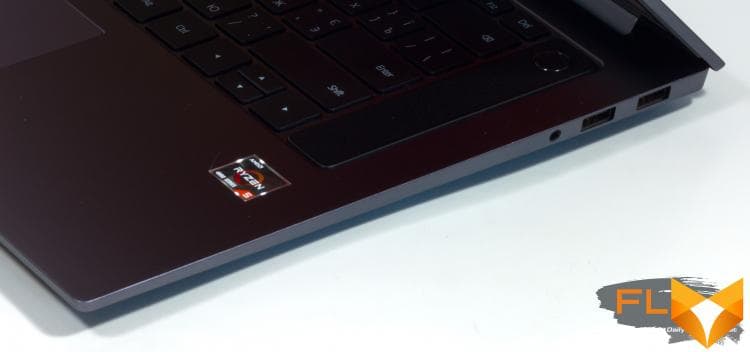
When a PSU and an external screen are connected to the laptop, one USB Type-C port will remain free if you use full-format HDMI. And for everything else, there’s a pair of USB Type-A and a 3.5mm TRS combo audio jack. The only pity is that there is no memory card reader.
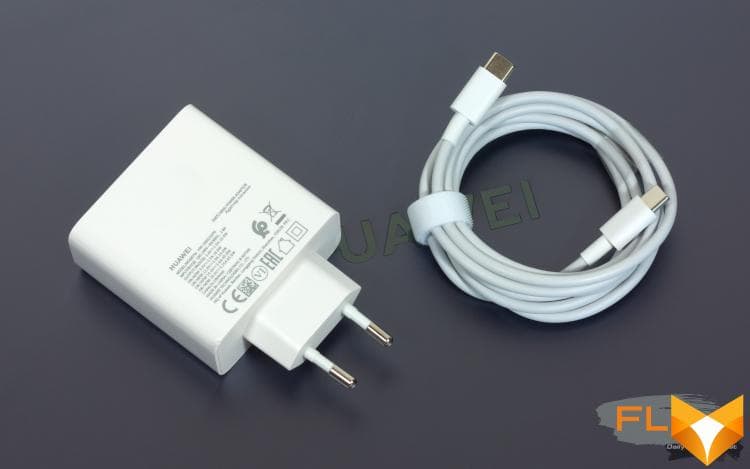
⇡#Internal design and upgrade options
The only reason a MateBook D 16 AMD owner would need to open up a laptop (other than cleaning dust) is to upgrade the ROM. HUAWEI opted for a fast 512GB WD PC SN 730 drive, but sooner or later that won’t be enough. At the same time, the old SSD can be left, because the motherboard has a free M.2 slot (and you can expand the memory up to 2 TB). But the laptop is not designed to expand the RAM: the chips are soldered on the motherboard.
Note that one of the two groups of external interfaces is mounted on its own PCB. This will make it easier to repair if any connector gets damaged. The only pity is that not the most common sockets are separated, that is, not USB Type-C, one of which is always used for charging, but USB Type-A.
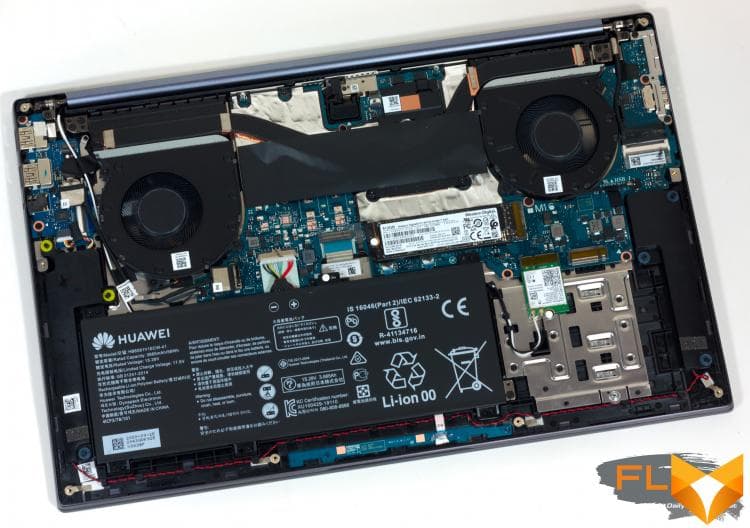
The MateBook D 16 AMD cooling system consists of two heatsinks connected by a common heat pipe. The cooler’s operation scheme is typical – cold air is sucked in through the mesh in the bottom of the case, and heated air leaves it through the gap between the topcase and the screen.
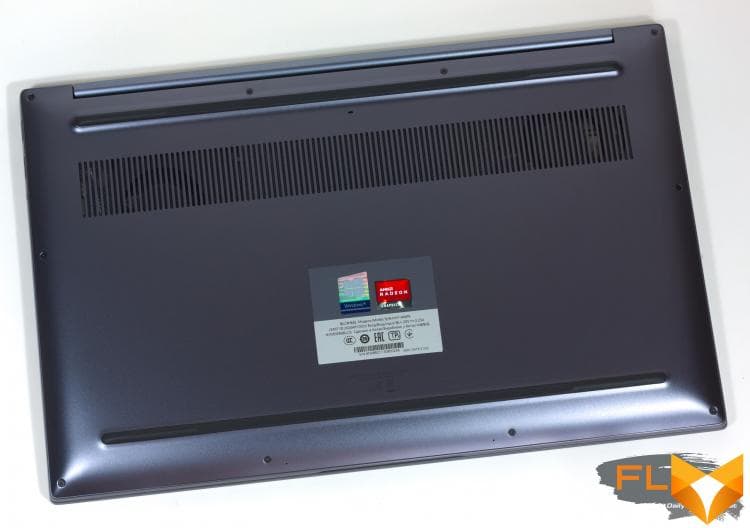
⇡#Test Methodology
| Synthetic tests | |
|---|---|
| Application | Settings |
| 3DMark Time Spy | — |
| Geekbench 4 | — |
| CINEBENCH R20 | — |
| GFXBench 5 (Aztec Ruins – Normal Tier, High Tier) | Windows: Vulkan, macOS: Metal |
| fio 3.16 | Sequential Read/Write, Random Read/Write (Unbuffered I/O) |
| Work Applications | |||||
|---|---|---|---|---|---|
| Application | Benchmark | Settings | API | ||
| Intel Graphics | AMD Graphics | NVIDIA Graphics | |||
| Adobe Photoshop CC 2019 | PugetBench for Photoshop CC 0.8 (test structure at link) | Basic Benchmark | OpenGL + OpenCL + Metal (macOS) | OpenGL + OpenCL + Metal (macOS) | OpenGL + OpenCL |
| Adobe Photoshop Lightroom Classic CC 2020 | PugetBench for Lightroom Classic 0.8 (test structure at link) | — | DirectX 12 (Windows) | DirectX 12 (Windows) | DirectX 12 |
| Adobe Premiere Pro CC 2019 | PugetBench for Premiere Pro 0.8 (test structure at link) | Standard Benchmark | OpenCL (Windows)/Metal (macOS) | OpenCL (Windows)/Metal (macOS) | CUDA |
| Blender 2.81a | Class Room Demo from Blender Foundation | Cycles renderer. Feature Set: Supported. Tile size: 32 × 32 (CPU) or 256 × 256 (GPU) | N/A (CPU rendering) | OpenCL | CUDA/OptX |
Display testing is performed using a Datacolor Spyder4 Elite colorimeter in ArgyllCMS and DisplayCAL 3 applications.
Notebook battery life is measured at a display brightness of 200 cd/m2in the following usage scenarios:
- web surfing: alternately opening and closing tabs of Computeruniverse.ru and Unsplash.com sites with an interval of 25 seconds in the Google Chrome browser (cache and cookies are disabled);
- Continuous playback of 4K HEVC (H.265) video.
⇡#Test participants
The following devices took part in testing:
| Screen | CPU | RAM | GPU | SSD | HDD | Battery | |||
|---|---|---|---|---|---|---|---|---|---|
| HUAWEI Matebook D 16 AMD (HVY-WAP9) | 16.1”, 1920 × 1080, IPS | AMD Ryzen 5 4600H | 6/12 cores/threads, 3.0-4.0 GHz | DDR4 SDRAM, 3200 MT/s, 16 GB | AMD Radeon RX Vega 6 | 512 MB from system RAM | WD PC SN730 (PCIe 3.0 x4) 512 GB | No | 56 Wh |
| Apple MacBook Pro 13″, Late 2020 (A2338) | 13.3”, 2560 × 1600, IPS | Apple M1 | 4+4 cores/threads, ≤3.2 GHz | LPDDR4X SDRAM, 4266 MT/s, 16 GB | 8 iGPU cores | System RAM | Apple AP2048Q (Apple Fabric) 2048 GB | No | 58.2 Wh |
| Apple MacBook Pro 16″, Late 2019 (A2141) | 16”, 3072 × 1920, IPS | Intel Core i9-9980HK | 8/16 cores/threads, 2.4-5.0 GHz | DDR4 SDRAM, 2666 MT/s, 16 GB | AMD Radeon Pro 5500M | 4GB GDDR6 | Apple AP1024N (PCIe 3.0 x4) 1024 GB | No | 100 Wh |
| ASUS VivoBook S15 (S533FL) | 15.6”, 1920 × 1080, IPS | Intel Core i7-10510U | 4/8 cores/threads, 1.8-4.9 GHz | DDR4 SDRAM, 2666 MT/s, 8 GB | NVIDIA GeForce MX250 | 2GB GDDR5 | Intel Optane Memory H10 (PCIe 3.0 x4) 32 + 512 GB | No | 50 Wh |
| HP ProBook 455 G7 (2D235EA) | 15.6”, 1920 × 1080, IPS | AMD Ryzen 5 4500U | 6/12 cores/threads, 2.3-4.0 GHz | DDR4 SDRAM, 3200 MT/s, 8 GB | AMD Radeon Vega 6 | 512 MB from system RAM | Samsung PM991 (PCIe 3.0 x4) 256 GB | No | 45 Wh |
| MSI Modern 15 (A10RB) | 15.6”, 1920 × 1080, IPS | Intel Core i7-10510U | 4/8 cores/threads, 1.8-4.9 GHz | DDR4 SDRAM, 2666 MT/s, 16 GB | NVIDIA GeForce MX250 | 2GB GDDR5 | WD PC SN730 (PCIe 3.0 x4) 512 GB | No | 52 Wh |
| MSI Modern 15 (A11SB) | 15,6”, 1920 × 1080, IPS | Intel Core i7-1165G7 | 4/8 cores/threads, 2.8-4.7 GHz | DDR4 SDRAM, 3200 MT/s, 16 GB | NVIDIA GeForce MX450 | 2GB GDDR5 | Kingston OM8PCP3512F-AI1 (PCIe 3.0 x2) 512GB | No | 52 Wh |
⇡#Screen Quality
HUAWEI MateBook D 16 is equipped with a high-quality screen matrix with Full HD resolution. By the standards of laptops of this form factor and price category, the panel has a high brightness – 286 cd / m 2 – and a decent contrast ratio, 870:1.

The color gamut of the screen exactly corresponds to the sRGB standard.
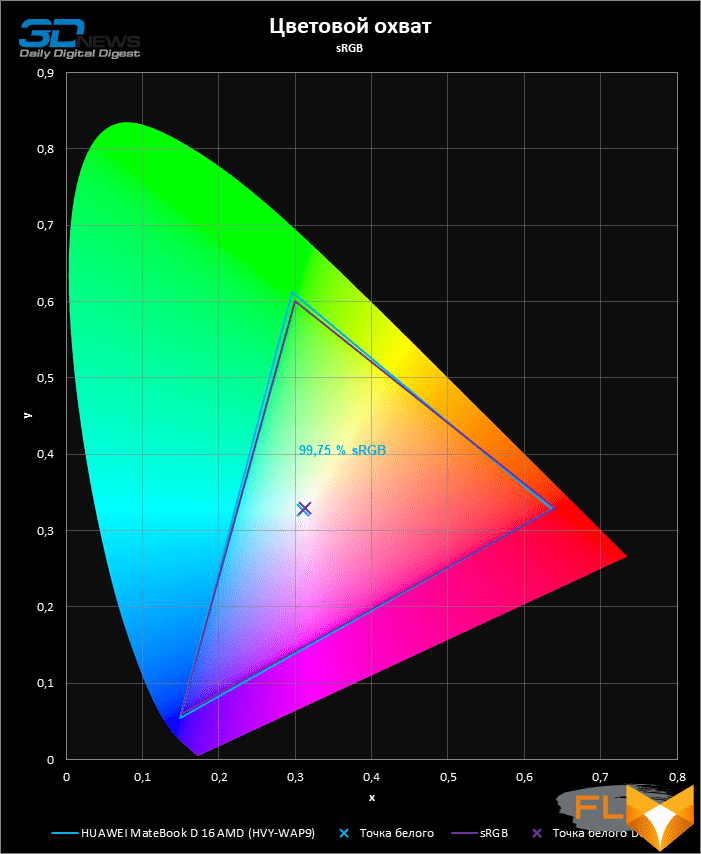
The white point is close to the reference value, and as a result, the color temperature of the image is about 6500 K.
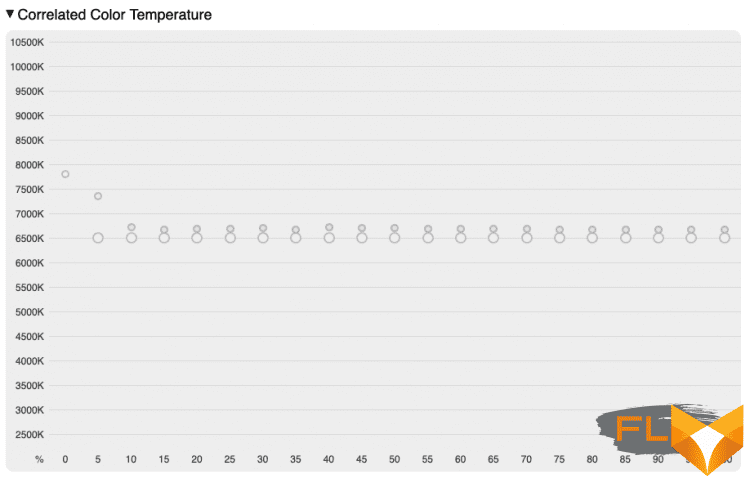
The base color curves converge well, but the gamma correction curve deviates from the reference function laid down in the sRGB standard. Fortunately, this did not lead to a significant loss of contrast throughout the gray scale.
|
 |
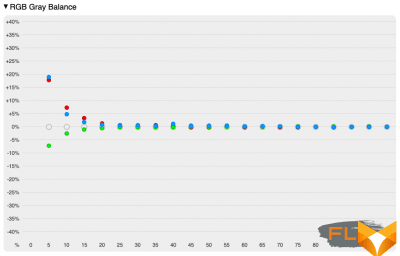 |
As a result of carefully fine-tuning the sensor parameters, the HUAWEI MateBook D 16 earned high marks for color accuracy, which would have flattered a professional monitor.
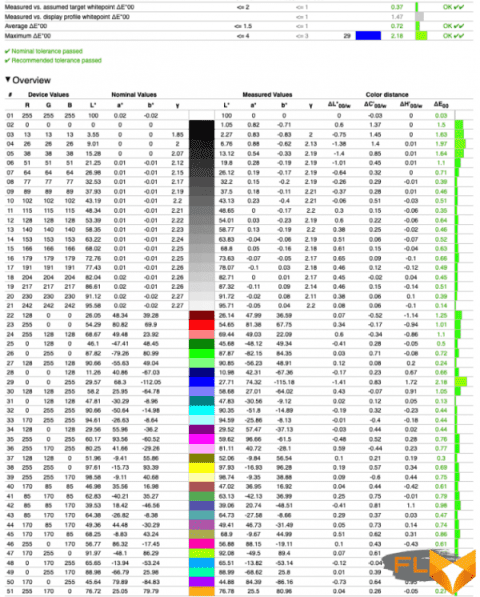
⇡#Clock speeds, temperature and noise levels
Not only is the thin HUAWEI laptop equipped with a high-powered CPU, the Ryzen 5 4600H chip exhausts a good part of the standard TDP here: at a maximum rating value of 54 W, the stable power consumption of the processor in maximum performance mode is 40 W. And the clock speeds are appropriate – about 3.7 GHz with six cores fully loaded. The laptop’s control software is able to put the CPU into moderate power consumption mode, but this does not affect the operating parameters much: the average chip power drops to 35 W, and the clock frequency to 3.6 GHz.
As for the integrated video adapter Radeon RX Vega 6, 3D rendering requires an average of 16 watts of power. This is nothing compared to loading exclusively on x86 cores, so changing the power consumption presets does not affect the SoC’s appetites under conditions of a predominantly graphics load, nor the GPU clock speed (1.5 GHz).
With intensive simultaneous load on the CPU and GPU, AMD automation puts the speed of the x86 cores in the foreground: their clock speed does not decrease much, while for the GPU it drops to 1.1 GHz.
| Load Clock | ||||||||
|---|---|---|---|---|---|---|---|---|
| Cinebench R20 (Max thread no.) | LuxMark 3.1 | Cinebench R20 (max thread no.) + LuxMark 3.1 | ||||||
| CPU clock speed, MHz | GPU clock speed, MHz | CPU clock speed, MHz | GPU clock speed, MHz | |||||
| Medium | Max | Medium | Max | Medium | Max | Medium | Max | |
| HUAWEI MateBook D 16 AMD (HVY-WAP9) — AMD Ryzen 5 4600H / AMD Radeon RX Vega 6 — Performance | 3720 | 3801 | 1479 | 1500 | 3547 | 3693 | 1074 | 1500 |
| HUAWEI MateBook D 16 AMD (HVY-WAP9) — AMD Ryzen 5 4600H / AMD Radeon RX Vega 6 — Balanced | 3587 | 3630 | 1500 | 1500 | 3407 | 3572 | 1121 | 1475 |
| CPU and GPU power | ||||||||
|---|---|---|---|---|---|---|---|---|
| Cinebench R20 (Max thread no.) | LuxMark 3.1 | Cinebench R20 (max thread no.) + LuxMark 3.1 | ||||||
| CPU Wattage | GPU power consumption (SoC as a whole for, if integrated), W | CPU Wattage | GPU power consumption (if discrete), W | |||||
| Medium | Max | Medium | Max | Medium | Max | Medium | Max | |
| HUAWEI MateBook D 16 AMD (HVY-WAP9) – AMD Ryzen 5 4600H / AMD Radeon RX Vega 6 – Performance | 40 | 44 | 13 | 16 | 40 | 41 | N/A | N/A |
| HUAWEI MateBook D 16 AMD (HVY-WAP9) – AMD Ryzen 5 4600H / AMD Radeon RX Vega 6 – Balanced | 35 | 36 | 13 | 16 | 35 | 36 | N/A | N/A |
Note The measurement is performed after the device has warmed up and all parameters have stabilized.
It is not surprising that with such a high power consumption under heavy load, the SoC crystal heats up in the thin chassis of the MateBook D 16 – up to 101 ° C, and the laptop is pretty noisy. Alas, the latter is a typical drawback of thin laptops with high-performance hardware. The “Balanced” power consumption mode has almost no effect on these parameters.
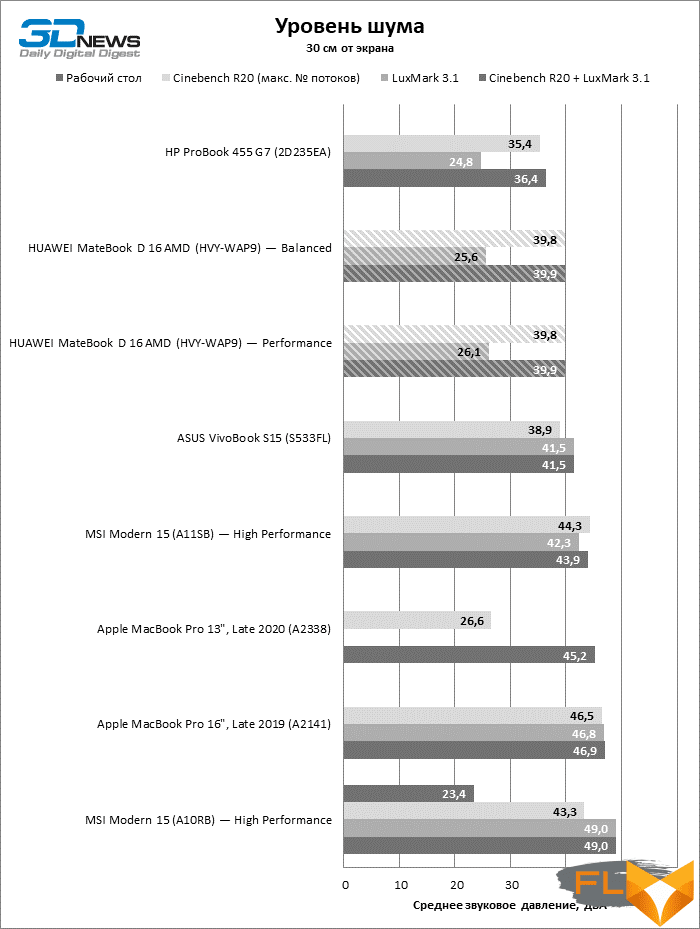
⇡#Synthetic performance tests
Although the Ryzen 5 4600H chip has only six cores, thanks to its high clock speeds and SMT support, it develops excellent multi-threaded performance. In the corresponding benchmarks, a HUAWEI laptop of similar characteristics with a 15-16-inch screen is only behind the MacBook Pro on an eight-core Intel CPU, but it is ahead of the MacBook Pro on the Apple M1 chip (however, the latter worked in x86 emulation mode).

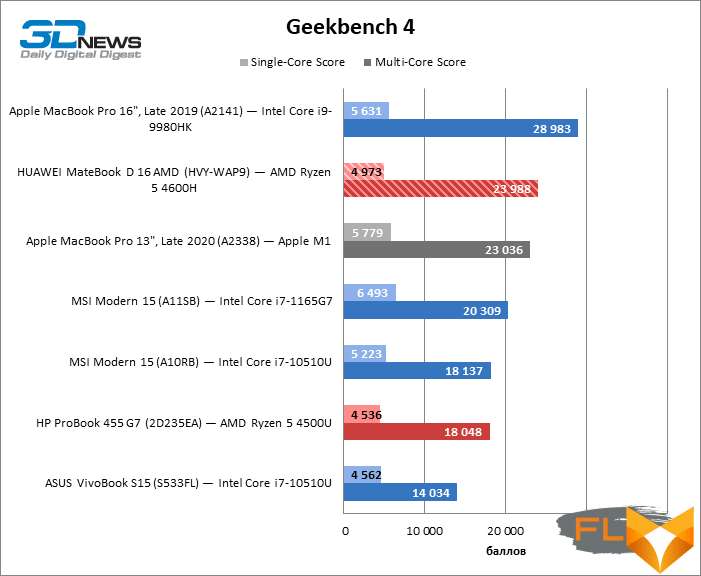
As for the integrated graphics of the Radeon RX Vega 6, it is not designed to work in any demanding work applications and games. Discrete entry-level GPUs easily outperform it in 3D rendering speed.
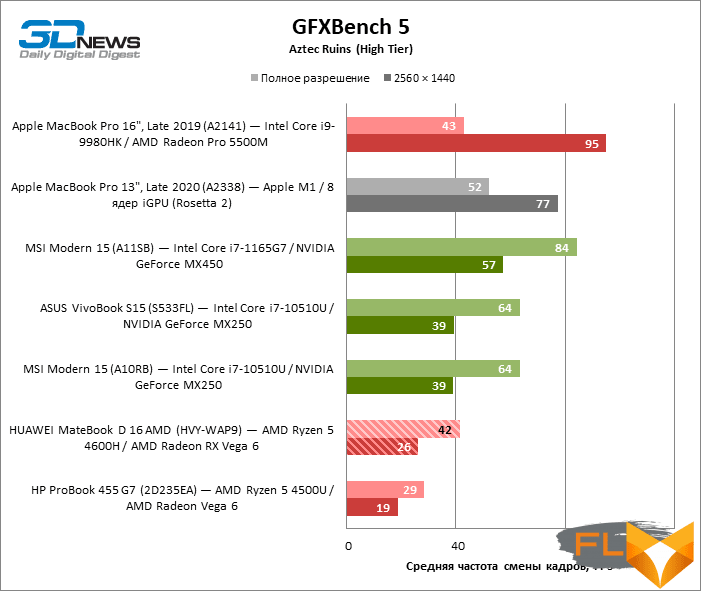
⇡#Performance in production applications
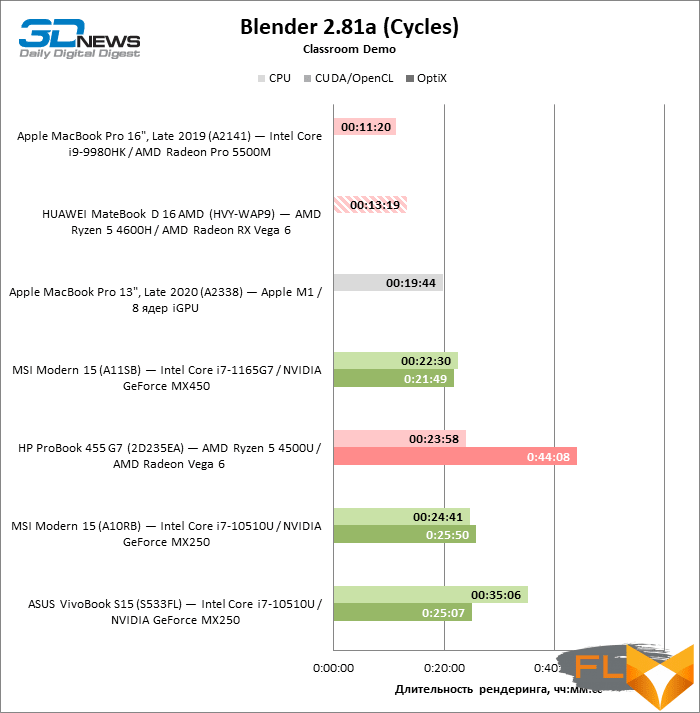
One of the best options for working in Lightroom these days is Intel’s 11th gen Tiger Lake processors, or powerful octa-core CPUs. Yes, and discrete graphics will not hurt. Whatever the case, the MateBook D 16 easily outperformed laptops with past generation quad-core Intel processors and low-wattage “red” chips in Lightroom performance.

Note Scores are calculated as a percentage of Intel Reference Workstation performance Core i9-9900K, NVIDIA GeForce RTX 2080, 64GB RAM.
In Photoshop, the HUAWEI laptop looks weak, yielding to rival machines based on eight- and even quad-core Intel CPUs along with entry-level discrete graphics – it is comparable in results to the MacBook Pro on the Apple M1 chip, provided that the latter is running in x86 emulation mode.
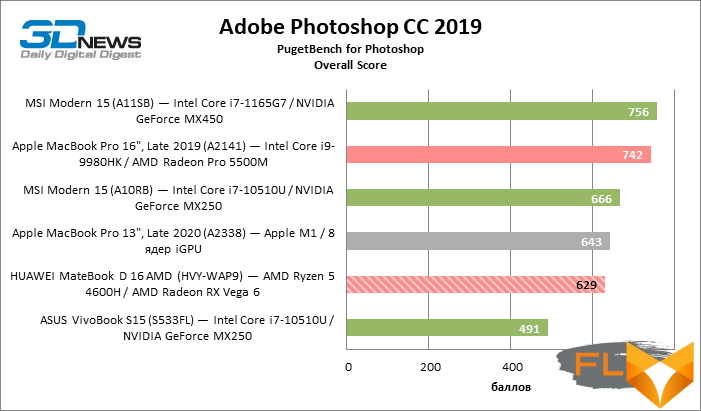
Note Scores are calculated as a percentage of Intel Reference Workstation performance Core i9-9900K, NVIDIA GeForce RTX 2080 and 64GB RAM x 10.

Note Scores are calculated as a percentage of Intel Reference Workstation performance Core i9-9900K, NVIDIA GeForce RTX 2080, 64GB RAM.
Engaging in video editing on a computer devoid of any powerful graphics processor, at first glance, is a failed idea. Nevertheless, if the editing does not contain complex effects that rely on the GPU, AMD’s MateBook D 16 develops impressive performance, sufficient to play a 4K project in half resolution with an acceptable frame rate, and a high export speed by the standards of mobile technology. Only eight cores, as well as the new MacBook Pro based on the Apple M1 platform, can count on the best result.
|
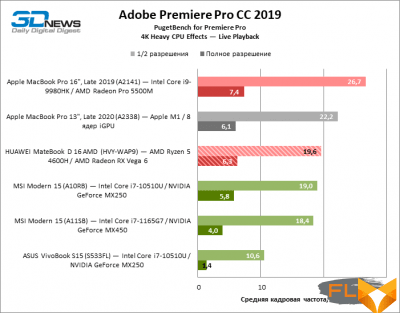 |
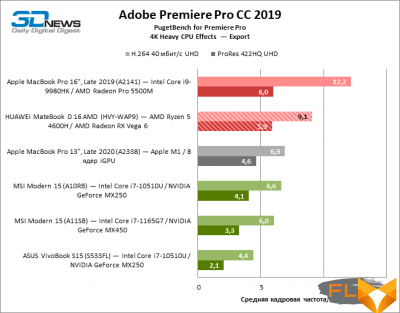 |
And if the project still uses resource-intensive effects, then in defense of the MateBook D 16 AMD, we can say that the discrete GPU of the GeForce MX250 level is not a big help here.
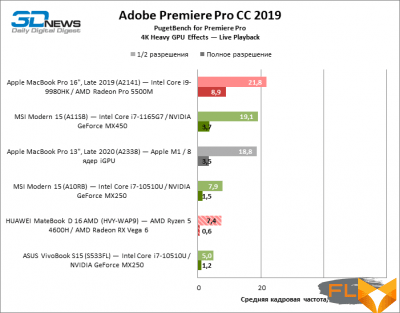 |
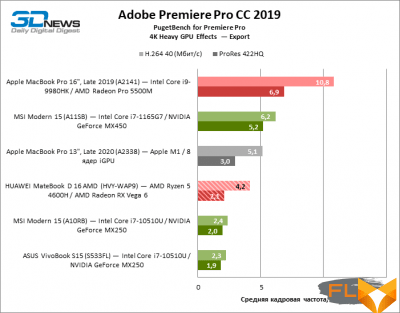 |
⇡# SSD Performance
HUAWEI chose the high-performance WD PC SN 730 drive. It features outstanding linear read and random block write throughput, as well as excellent results in the random read test. At the same time, the weakness of the PC SN 730 is the low speed of linear recording.
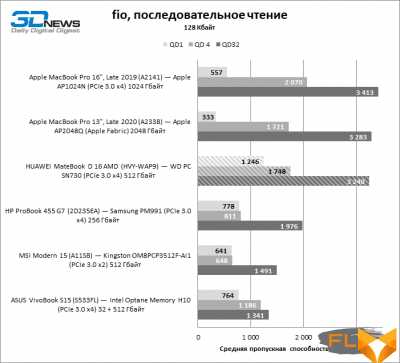 |
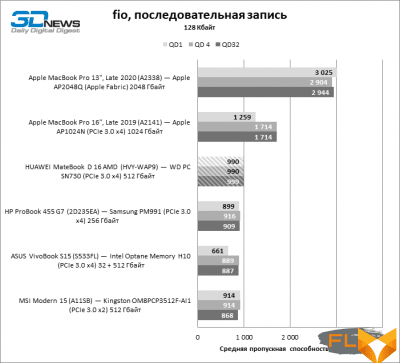 |
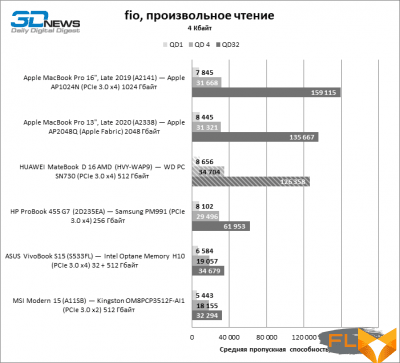 |
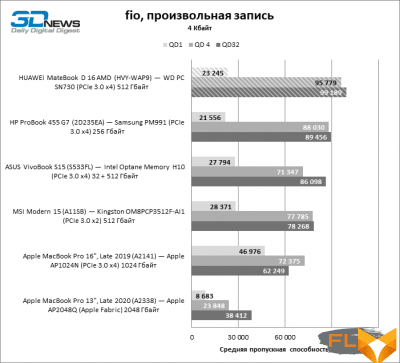 |
⇡# Battery Life
In terms of life on a single charge when playing HEVC video, the MateBook D 16 AMD does not stand out among laptops with similar dimensions and battery capacity: a little less than 7 hours. However, the HUAWEI laptop lasted the longest with continuous web surfing – no less than 8 hours.
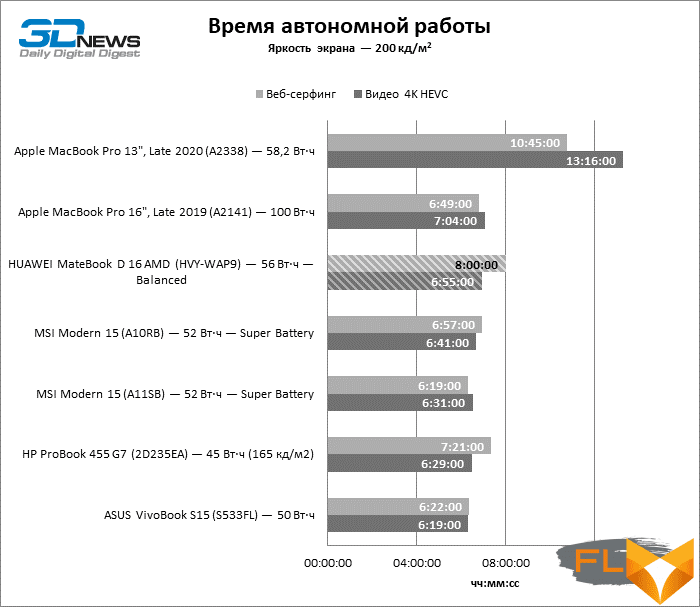
⇡#Conclusions
This is extremely rare, but it is difficult to find at least some reason for serious criticism in the new HUAWEI laptop. It is only necessary to consider what tasks it is designed for, and what it is not. In terms of CPU speed, this is one of the leaders in its class, which uses predominantly low-wattage Intel or AMD chips, because AMD’s MateBook D 16 has a six-core Ryzen 5 4600H processor with full power. The only thing worth preparing for is the noise of the cooling system under full load, but high-performance ultrabooks do not work differently. In addition, AMD’s MateBook D 16 does not have a discrete GPU, which makes it unsuitable for some work applications and modern games. But by sacrificing a discrete GPU, it was possible to extend the battery life.
However, HUAWEI clearly understands that the main thing that distinguishes a good laptop from a mediocre one is not the filling at all, but the quality of the screen, chassis design and controls. The screen here, though not the brightest and most contrasty, but perfectly tuned, the case is durable and tough. Well, in terms of keyboard mechanics, only a few manufacturers can now compete with what HUAWEI does. With such a list of advantages as AMD’s MateBook D 16, the laptop could easily cost much more, and in its price category we find it difficult to name suitable competitors.
